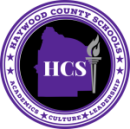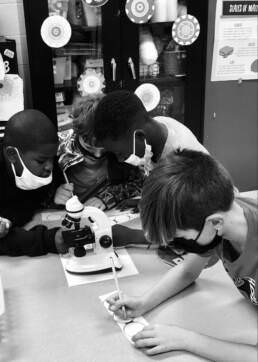Rachel Winberry – STEAM – East Side
After learning the basic principles of STEAM at Anderson Early Childhood Center and Haywood Elementary, Haywood County students begin to put those principles to practice at East Side Elementary School under the direction of first-year STEAM teacher Rachel Winberry.
While Rachel is in her first year teaching STEAM, she is a veteran teacher of 14 years which helps her as she adjusts to teaching a brand new subject. She also appreciates the flexibility that comes with teaching STEAM.
“The transition to STEAM has been neat because I don’t have a set curriculum. I can get more of the kids’ input about what they want to learn and then link it to either Science or Art or Technology. It really gives the students ownership in their learning,” she said.
Because STEAM does provide more hands-on learning opportunities for students, it allows Rachel to be more of a facilitator of learning in the classroom while also providing the flexibility of a fluid curriculum.
“The students only get 40 minutes with me once a week, so if we need to extend a project to the next week, we can. I don’t feel like I’m under as much of a time crunch as I was with teaching Science and Social Studies,” Rachel explained. “There are a lot more hands-on learning activities. And a lot more of facilitating the learning process for the students as they work through projects.”
One project the students worked on recently at East Side STEAM was designing and building a marshmallow launcher from start to finish. This project was directly connected to the engineering aspect of STEAM.
“When we started the engineering process, there was a full lesson on the steps that engineers take in the creation process. Then, the students got their materials and had time to plan with their table,” Rachel said. “The students had to build a structure out of Legos and then they had to also build a marshmallow launcher that used a balloon to launch it across the room. We measured how far the marshmallow flew and had different competitions between tables.”
While the project itself was obviously important, the inherent lesson taught and learned through group communication and collaboration was what was most important for Rachel.
“The students did really well with that project. It was interesting to see the kids who had a natural affinity for this type of project. It was neat to see them problem-solve together when they came to a sticking point and had to decide in which direction to move ahead,” Rachel said. “Learning each other’s personalities and how they work with other students is important at this age. We usually take 10 minutes as a class and to plan out how the groups will work – what each student’s role will be within that group and how they all work together.”
This Fall, students in Rachel’s class enjoyed doing Spooky Stations. These stations allowed students the freedom to participate in a variety of STEAM activities during one class period. One station had students building a tower in order to balance a pumpkin on top of it. Another station allowed students to observe “pumpkin guts” under a microscope. While a third station allowed students to replicate a real spider web by using string.
The advantages of having hands-on activities centered around Science, Technology, Engineering, Arts, and Mathematics for young learners are obvious, the real synthesizing occurs when Rachel combines and reinforces what the students are learning in the core subjects with what they are learning in STEAM.
“I communicate with their classroom teachers,” Rachel said. “At this time, third grade is working with animal and plant adaptations and we’re currently working with different blood samples under the microscope. We’ve got human, frog, and bird so they’re going to see the differences in those blood types and why they may look different.”
Rachel understands the importance of her role and the immediate needs of her STEAM students, but she also sees the future benefits in giving students opportunities in this subject area.
“I think knowing that the world is heading in a direction with a science and technology emphasis, this class is so important for exposing children to those principles.”


